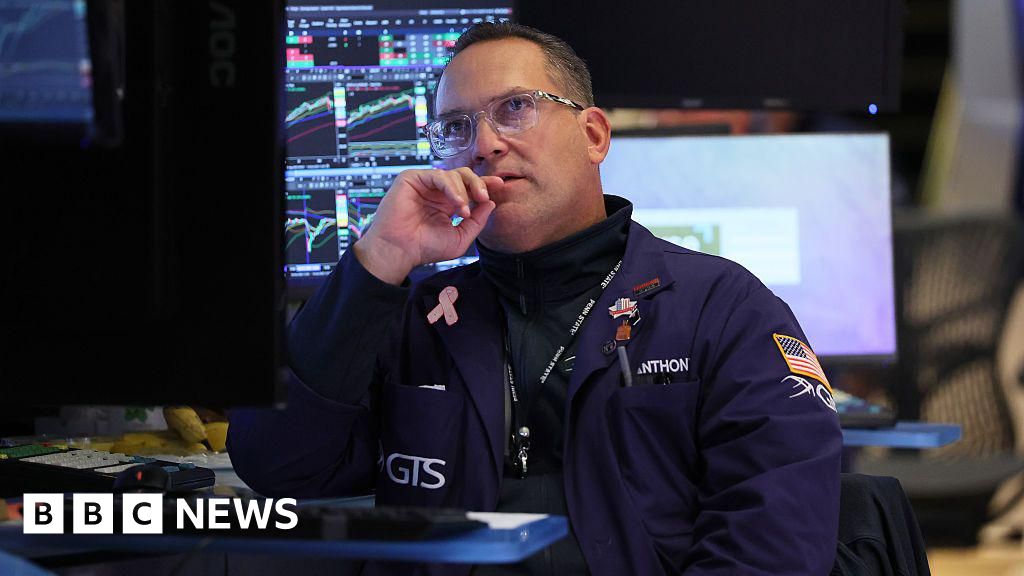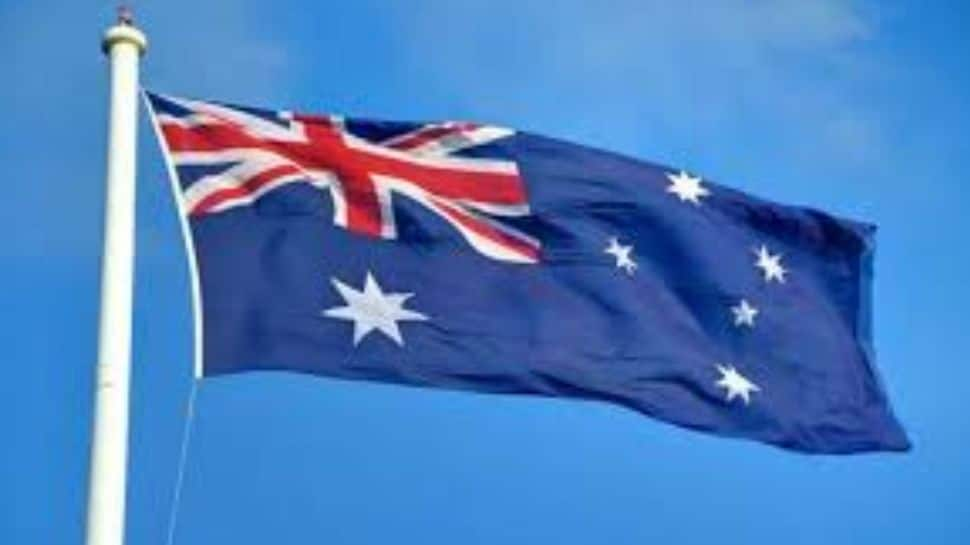Business
How nervous are investors about the stock market?

Every week it seems US financial markets are hit by another bout of fear.
The latest worries spread this week from the banking sector in the US, after two regional lenders warned they would be hit by losses from alleged fraud.
But before that, markets swooned over signs of rekindled US-China tensions, as the two superpowers face off over tariffs, advanced technology and access to rare earths.
The bankruptcies of car parts supplier First Brands and subprime car lender Tricolor acted as a trigger for nervous chatter in September.
Over the last month, US shares, which had been climbing since their tariff-induced rout in April, have flattened.
But in many ways the market swings so far – down roughly 3% at the steepest – are not unusual.
Zooming out, the major indexes have still posted gains since the start of the year, with the S&P 500 up roughly 13%. That’s smaller than 2024 but still solid.
“The market has done surprisingly well so far this year … driven by an improvement in corporate profits and the enthusiasm surrounding AI,” says Sam Stovall, chief investment strategist at CFRA Research.
The resilience of the stock market is, ironically, exactly what is driving some of the jitters.
Put simply, when set against other standard metrics like profits, share prices in the US are very high.
Meanwhile, concerns about a possible bubble emerging in the artificial intelligence (AI) industry have generated a steady undercurrent of talk since the start of the year – discussions that have ramped up as analysts struggle to see how the vast sums of money the biggest players are throwing at one another all fit together.
The Bank of England warned recently of “stretched valuations” and rising risk of a “sharp market correction”.
Those concerns were echoed in remarks from JP Morgan Chase boss Jamie Dimon and to some extent US central bank chair Jerome Powell.
The International Monetary Fund was the latest to chime in this week.
“Markets appear complacent as the ground shifts,” it said in its financial stability report, which noted risks from trade tensions, geopolitical uncertainty and rising sovereign indebtedness.
James Reilley, senior markets economist at Capital Economics, said the market falls triggered by the regional banks were a sign of investors alert to risk and moving quickly to reduce exposure amid uncertainty about whether the losses were indicative of wider issues.
But he said the brief nature of the drops showed how quickly such worries could clear.
Many investors remain optimistic, with analysts at firms such as Goldman Sachs and Wells Fargo in recent weeks boosting their forecasts for where the S&P 500 might climb by the end of the year.
David Lefkowitz, head of US equities at UBS Global Wealth Management, said he thought a sharp sell-off was unlikely at a time when growth in the US remains solid and the US central bank is lowering borrowing costs.
He is expecting the S&P 500 to end the year hovering around 6,900 points, about 4% higher than where it sits on Friday.
While he acknowledged the troubles popping up at banks, he noted that the lenders involved have alleged fraud.
He said the overall picture, when looking at default levels, appears healthy, and he saw little risk that demand for AI would suddenly decline, puncturing valuations.
“I’m not saying we’re in a bubble. I’m not saying we’re not in a bubble. The question is what’s going to drive the downside,” he said. “Things don’t usually spontaneously decline.”
A typical bull market – when shares are rising – lasts about four and a half years, said Mr Stovall.
With inflation still sticky, and investors wary of events in Washington, like the government shutdown and Trump administration’s efforts to influence the US central bank, this year’s market rally has been “unloved”, said Mr Stovall.
On the other hand, he noted: “It’s just a matter of time. Corrections and bear markets have not been repealed. They might simply be delayed.”
Business
Third-quarter earnings are indicating a divided economy

A Taco Bell restaurant in El Cerrito, California, US, on Tuesday, April 29, 2025.
David Paul Morris | Bloomberg | Getty Images
With more consumer companies preparing to report third-quarter earnings this week, Wall Street will be watching for signs of a bifurcated or “K-shaped” economy as consumers diverge in their spending behaviors.
There have been increasing signals that wealthier Americans are spending more while lower-income Americans are significantly paring back their spending. Lower-income consumers have been hit hardest by rising inflation and escalating prices on essentials, with September’s consumer price index report indicating a 0.3% increase on the month, putting the annual inflation rate at 3%.
Shortly after the CPI report was released, the Federal Reserve on Wednesday approved its second straight interest rate cut, lowering its benchmark overnight borrowing rate to a range of 3.75% to 4%.
Meanwhile, the country is entering the fifth week of the government shutdown, with many federal workers going without pay.
The Census Bureau estimated there were 35.9 million people in poverty in 2024, the most recent available data, with the weighted average poverty threshold for a family of four coming in at $32,130. The median household income, meanwhile was $83,730 last year, according to the bureau.
The top 10% of households saw their income increase 4.2% between 2023 and 2024, but there was no meaningful change for the bottom 10% of households, the bureau said in September. There were approximately 33 million households in the top 10% of earners and another 33 million in the bottom 10% of earners as of last year.
Consumers with the highest purchasing power have benefited from stock market rallies and rising home values. Data from JPMorgan‘s Cost of Living Survey found that higher-income consumers reported stronger economic confidence readings for the next year.
Recent earnings reports from companies touching all corners of the economy have indicated the K-shaped trend is beginning to take hold. This week, companies like Yum Brands, McDonald’s, E.l.f. Beauty, Tapestry and Under Armour are preparing to release quarterly earnings reports and could report similar trends.
Last week, Chipotle reported it’s seeing consumers who make less than $100,000 a year, which represents roughly 40% of the company’s customer base, spending less frequently due to concerns about the economy and inflation. CEO Scott Boatwright said the company is seeing “consistent macroeconomic pressures” with a 0.8% decline in traffic for the quarter.
Coca-Cola said in its third-quarter earnings that pricier products like Topo Chico sparkling water and Fairlife protein shakes are driving its growth. Procter & Gamble reported similar results, saying wealthier customers are buying more from club retailers, which sell bigger pack sizes, while lower-income shoppers are significantly pulling back.
And some of the companies reporting this week have already indicated they may be seeing similar behaviors. In early September, McDonald’s CEO Chris Kempczinski told CNBC’s “Squawk Box” that the chain’s expansion of its value menu was due to a “two-tier economy.”
“Traffic for lower-income consumers is down double digits, and it’s because people are either choosing to skip a meal … or they’re choosing to just eat at home,” he said.
The trend isn’t limited to just food and beverage, either. In the autos world, consumers who can afford to buy new vehicles are on a spree, while those who are more price constrained are sitting out. Defaults and repossessions are on the rise while the average price for a new vehicle is setting records.
And in the service industry, Hilton earlier this month reported that it saw a drop in revenue for its affordable brands while its luxury offerings performed exceedingly well. Still, CEO Christopher Nassetta told CNBC last month that he doesn’t expect bifurcation to last much longer.
“My own belief is that as we look into the fourth quarter and particularly into next year, we’re going to see a very big shift in those dynamics, meaning, I don’t think you’re going to continue to have this bifurcation,” Nassetta said. “That’s not to say I think the high end is going to get worse or bad. I just think the middle and the low end [are] going to move up.”
Correction: This article has been updated to correct the month of the CPI report.
Business
Kimberly-Clark agrees to buy Tylenol owner Kenvue in $48.7 billion deal, creating consumer staples giant

Huggies, manufactured by Kimberly-Clark and Band-Aid, manufactured by Kenvue.
Getty Images
Kimberly-Clark announced Monday it’s struck an agreement to buy Kenvue in a deal valued at $48.7 billion that would create a consumer staples giant.
The deal is a combination of cash and stock and totals about $40 billion on an equity basis, excluding the impact of debt. Shares of Kenvue surged 15% Monday, while Kimberly-Clark stock fell 13%.
The combined company would bring together brands like Huggies and Kleenex with the likes of Band-Aid and Tylenol. It would include 10 billion-dollar brands, the companies said in a news release. The acquisition would be one of the largest on Wall Street this year.
The transaction is expected to close in the second half of 2026.
Kimberly-Clark Chairman and CEO Mike Hsu said in a statement that the companies share a “commitment to developing science and technology to provide extraordinary care.”
“Over the last several years, Kimberly-Clark has undertaken a significant transformation to pivot our portfolio to higher-growth, higher-margin businesses while rewiring our organization to work smarter and faster,” Hsu said. “We have built the foundation and this transaction is a powerful next step in our journey.”
Kenvue, a portfolio of consumer health brands, spun out of Johnson & Johnson in May 2023, marking the biggest shake-up in J&J’s nearly 140-year history. Since then, Kenvue shares have fallen almost 35% from their initial public offering price. As of Friday’s close, Kenvue traded at about $14 per share for a market cap of roughly $27 billion.
J&J has sold all of its remaining stake in the consumer goods giant.
The deal comes just weeks after President Donald Trump made unfounded claims linking the use of acetaminophen — the active ingredient in Tylenol — during pregnancy to an increased risk of autism, sending Kenvue’s stock sharply lower. The company has staunchly pushed back against his administration’s accusation, and many medical experts say Tylenol is often the safest and only option for pain and fever relief in pregnant women.
Acetaminophen is used by upward of 100 million Americans annually.
Kenvue Chair Larry Merlo said in a statement that following a comprehensive strategic review, the board is “confident this combination represents the best path forward for our shareholders and all other stakeholders.”
Three Kenvue board members will join the Kimberly-Clark board upon the deal’s closing. Hsu will continue to serve as chairman and CEO.
The combined company would generate estimated 2025 annual net revenue of roughly $32 billion and adjusted earnings before interest, taxes, depreciation and amortization of approximately $7 billion, according to the release.
Kimberly-Clark and Kenvue expect about $1.9 billion in cost synergies from the transaction to be realized in the first three years following the deal’s close.
The acquisition comes as Kimberly-Clark and the broader consumer packaged goods industry try to address shifting demand and shopping behavior, often through deal-making and divestitures.
Tariffs imposed by Trump’s administration have challenged the industry and its profits as key commodities like pulp, which is used to make tissues and diapers, grow more expensive.
At the beginning of 2025, Kimberly-Clark stopped making private-label diapers for Costco to focus on more premium brands that command higher margins.
In June, the company sold a majority stake in its international tissue business to Brazilian pulp maker Suzano. The resulting joint venture is intended to shield Kimberly-Clark from volatile input costs and help stabilize its margins.
Once the deal closes, Kimberly-Clark will own health-care brands like Sudafed and Pepcid, once again pitting the company against rival Procter & Gamble, which has a health-care division that includes Pepto-Bismol and Vicks.
But even with Kimberly-Clark’s blockbuster acquisition, P&G still dwarfs its rival in both enterprise value and annual revenue. P&G has a market cap of about $350 billion.
Similar to Kenvue, other spinoffs have also recently proven to be popular acquisition targets. Last year, candy maker Mars announced plans to buy Kellanova, a snacking-centric spinoff of Kellogg, while Ferrero bought W.K. Kellogg, the cereal stand-alone, this year.
Business
India, New Zealand Hold 4th FTA Talks In Auckland On Trade Rules

New Delhi: The fourth round (November 3-7, 2025) of negotiations for the India-New Zealand Free Trade Agreement (FTA) commenced on Monday in Auckland, New Zealand, marking another step forward in advancing a balanced, comprehensive, and mutually beneficial partnership between the two nations.
According to India’s commerce ministry, this development builds on the shared commitment to deepen economic ties and guidance given by Prime Minister Narendra Modi during the visit of the New Zealand counterpart Christopher Luxon, Prime Minister in March 2025.
The FTA was launched during the meeting between Piyush Goyal, Minister of Commerce and Industry, Todd McClay, Minister for Trade and Investment, New Zealand on March 16, 2025.
Negotiations in this round are focusing on key areas, including Trade in Goods, Trade in Services, and Rules of Origin, the commerce ministry said in a statement today.
“Both sides are working constructively to build on the progress achieved in earlier rounds, to reach convergence on outstanding issues and move towards the early conclusion of the FTA,” the statement added
India and New Zealand reiterated their commitment to developing a forward-looking and inclusive trade framework that supports sustainable growth and shared prosperity for both economies.
India is actively negotiating trade agreements with nearly a dozen countries, including the United States, the European Union, Australia, Sri Lanka, Qatar, and several others, in a bid to expand trade and secure long-term growth opportunities.
The coming months are expected to be critical, when the outcomes of these negotiations could redefine India’s role in the global trade architecture and shape its economic trajectory for the next decade.
India has, over the past 5 years, inked several trade deals, including the India-Mauritius Comprehensive Economic Cooperation and Partnership Agreement (CECPA) implemented in 2021, the India-UAE Comprehensive Economic Partnership Agreement (CEPA) and the India-Australia Economic Cooperation and Trade Agreement (ECTA) in 2022, the India-European Free Trade Association (EFTA) Trade and Economic Partnership Agreement (TEPA) in 2024, and the India-UK Comprehensive Economic and Trade Agreement (CETA) signed in 2025, which is understandably yet to come into force.
Negotiations for a comprehensive trade deal between India and Oman, which commenced in 2023, were recently concluded.
-

 Tech6 days ago
Tech6 days agoOpenAI says a million ChatGPT users talk about suicide
-

 Tech6 days ago
Tech6 days agoHow digital technologies can support a circular economy
-

 Tech6 days ago
Tech6 days agoUS Ralph Lauren partners with Microsoft for AI shopping experience
-

 Tech6 days ago
Tech6 days agoAI chatbots are becoming everyday tools for mundane tasks, use data shows
-

 Fashion6 days ago
Fashion6 days agoITMF elects new board at 2025 Yogyakarta conference
-

 Entertainment1 week ago
Entertainment1 week agoGrimes backs Selena Gomez after ‘In The Dark’ video
-

 Fashion1 week ago
Fashion1 week agoTaiwan Textile Select showcases sustainable innovation at TITAS 2025
-

 Tech1 week ago
Tech1 week agoHere’s How Many People May Use ChatGPT During a Mental Health Crisis Each Week






